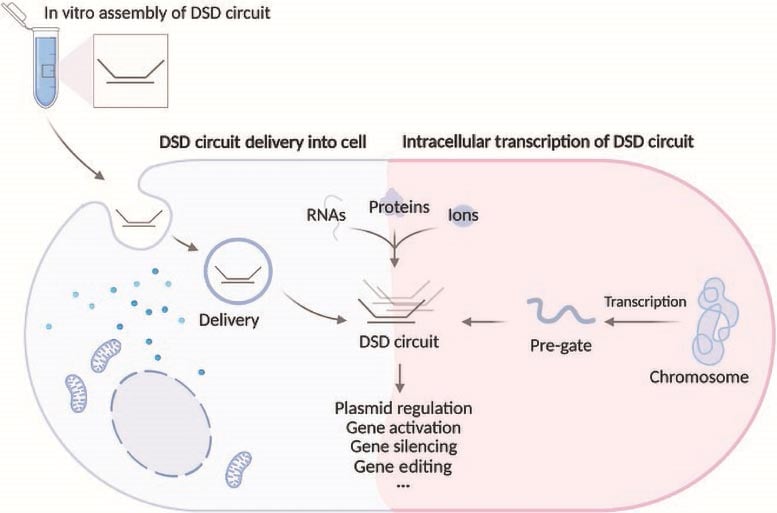
<span class="glossaryLink" aria-describedby="tt" data-cmtooltip="
” data-gt-translate-attributes=”[{"attribute":"data-cmtooltip", "format":"html"}]” tabindex=”0″ role=”link”>DNA strand displacement circuits are inching closer to becoming cellular machines.
Scientists are finding ways to make these programmable nanodevices stable and functional inside living cells. If successful, they could revolutionize how we interface with and control biology at the molecular level.
DNA Computing Circuits Come Alive in Cells
A recent review published in Intelligent Computing, titled “From the Test Tube to the Cell: A Homecoming for DNA Computing Circuits?” outlines major advances in the effort to bring DNA computing circuits into living cells. The authors describe how dynamic nanodevices powered by DNA strand displacement reactions could soon perform real-time computing, sensing, and control inside biological systems – opening the door to a new generation of “molecular robots” that interact directly with cellular environments.
How DNA Strand Displacement Powers Molecular Logic
At the core of this technology are DNA strand displacement circuits, a key component of dynamic DNA nanotechnology. These circuits use toehold-mediated strand displacement: a process where an incoming DNA strand binds to a short, exposed region called a toehold, and then displaces an existing strand through branch migration.
Foundational systems such as seesaw gates and hybridization chain reactions enable complex logic operations and signal amplification, while cooperative gates require multiple inputs to produce an output, allowing for sophisticated control. These individual components can be combined into larger networks that simulate formal chemical reaction pathways. DNA strand displacement also connects to structural n anodevices like DNA origami and DNA assemblies, enabling controlled shape changes and expanding the range of biological applications.

Biological Inputs for DNA-Based Sensing
According to the authors, “DNA strand displacement reactions can be triggered by biological components such as nucleic acids, small molecules, proteins, and ions.”
Nucleic acids, such as DNA and <span class="glossaryLink" aria-describedby="tt" data-cmtooltip="
” data-gt-translate-attributes=”[{"attribute":"data-cmtooltip", "format":"html"}]” tabindex=”0″ role=”link”>RNA, serve as direct inputs by leveraging complementary substrate designs, allowing applications in transcriptome analysis and live-cell monitoring. Input detection can be achieved through aptamers, which are single-stranded nucleic <span class="glossaryLink" aria-describedby="tt" data-cmtooltip="
” data-gt-translate-attributes=”[{"attribute":"data-cmtooltip", "format":"html"}]” tabindex=”0″ role=”link”>acid sequences that bind to targets or ligands with high affinity and specificity.
To link aptamers to DNA strand displacement modules, various methods such as structure-switching aptamers, associative toeholds, hidden toeholds, remote toeholds, transient toeholds, chemical ligation, metallo-toeholds and DNAzymes have been developed to ensure precise signal transduction from biological targets to downstream circuits.
Challenges and Solutions for In-Cell Functionality
Currently, DNA strand displacement is primarily applied in vitro, and its application in vivo faces major challenges, including rapid degradation by DNA degrading enzymes. To enhance stability, researchers have explored structural modifications such as terminal protections like hairpins and protein binding sites, as well as chemical modifications like 2’-O-methylation.
Since most cells naturally repel DNA, delivering these nanodevices into cells requires specialized techniques, such as transfection methods and transformation protocols. Once inside, cellular factors such as salt concentration, molecular crowding, and heterogeneous environments influence strand displacement reactions. To overcome the limitations of direct delivery, researchers are also developing transcribable RNA nanodevices encoded into plasmids or chromosomes, allowing cells to express these circuits.
Toward Smart DNA Machines and Biocomputers
DNA strand displacement has been applied to the innovation of computational models. By integrating computational principles with DNA strand displacement, the structured algorithms of traditional computing can be combined with random biochemical processes and chemical reactions in biological systems, enabling biocompatible models of computation. In the future, DNA strand displacement may enable autonomously acting DNA nanomachines to precisely manipulate biological processes, leading to quantum leaps in healthcare and life science research.
Reference: “From the Test Tube to the Cell: A Homecoming for DNA Computing Circuits?” by Hyeyun Jung, Ethan Collinson, Alexander Patrick Hawes and Harold Fellermann, 4 March 2025, Intelligent Computing.
DOI: 10.34133/icomputing.0112
